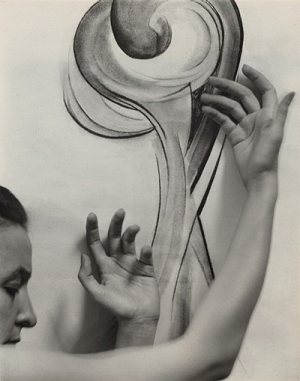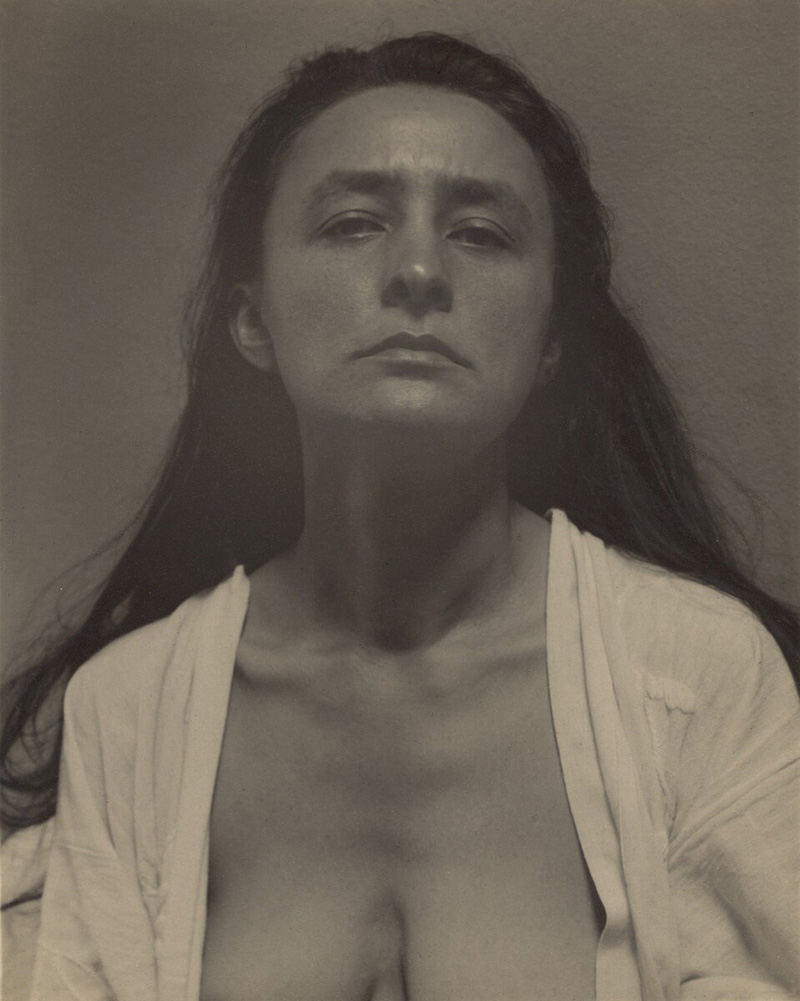
Alfred Stieglitz, Georgia O’Keeffe, 1918, printed 1924/1937, gelatin silver print, National Gallery of Art, Washington, Alfred Stieglitz Collection, 1980.70.66
Key Set number 490
In 1917, amid the tumult of US entry into World War I, the two great projects that had consumed Alfred Stieglitz for more than a decade—Camera Work and the gallery 291—came to an end. The next year, the fifty-four-year-old photographer and the artist Georgia O’Keeffe, who was twenty-three years younger, became lovers, catalyzing a burst of creativity unprecedented in Stieglitz’s long career: from 1918 to 1920, Stieglitz made more than 140 photographs of O’Keeffe that, unlike his earlier analytic work, resonated with emotion and personal meaning.
Stieglitz made his first portraits of O’Keeffe at 291 in 1917, shortly before the gallery closed. Like his other 291 portraits of artists, Stieglitz posed O’Keeffe in front of her art; in one her head is framed, halolike, by a circular form in her drawing (Key Set number 457). He continued to pose O’Keeffe in front of her drawings in 1918, but as their intimacy grew, he began to conjoin her art and her body, suggesting they were one (Key Set number 490).
As O’Keeffe quickly became more comfortable with his scrutiny, Stieglitz focused on her less as an artist than as a lover. In several photographs, wearing a loose or open kimono, she looks directly and longingly at the camera (Key Set number 501). Other photographs lavish attention on isolated parts of her body, including her torso, legs, feet, and hands. These independent studies express Stieglitz’s passion as well as his belief that different body parts were expressive of O’Keeffe’s individuality (Key Set number 514). The many portraits of her hands, in particular, including extreme close-ups, evoke an intimate sense of touch (Key Set number 531).
Stieglitz conceived of his portraits of O’Keeffe as a single work—a composite portrait. Each photograph stands on its own, revealing a certain innate quality at a given moment. But because change is a constant, only a series of photographs can evoke a subject’s entire being over time. To underscore the composite nature of his project, in 1921 Stieglitz exhibited more than forty photographs of O’Keeffe—many clustered by body part—under the title “Demonstration of Portraiture.”
Stieglitz and O’Keeffe married in 1924, and he continued to photograph her through the 1930s—his composite portrait eventually numbering 331 works. But his pictures of her changed markedly over the years. In 1923 when he became entranced with photographing clouds, he made smaller, more casual pictures of her at work or holding the subjects of her paintings. Many of his portraits of her from the 1930s lack the feverish intensity of those he made from 1918 to 1920 and reveal instead the distance in their relationship.
Previous: The 291 Years, 1905–1917 | Next: The 1920s



